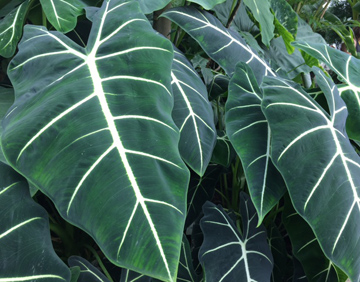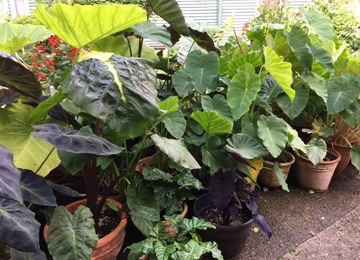
I don’t believe I’d ever seen as many big leaves outside of a conservatory as I did in Buffalo, New York, last summer. In the small residential gardens I was touring, elephant ears in pots were everywhere, doing their best to bring a tropical air to the place. I could easily understand why a hint of the tropics would appeal to gardeners making the most of a five-month growing season in a city that gets 90 inches of snow a year.
Elephant ears can be a dramatic focal point in any garden. Those leaves, sometimes as big as pillowcases, make a striking contrast to most other foliage. They’re tropical plants, winter-hardy only in USDA Zones 9 and 10. But if you grow them in containers, you can bring them into the greenhouse in October and keep them green all winter in a cold-winter place. Or you can let the plant go dormant and overwinter it, right in the pot, in a cool, but not freezing, basement until the danger of frost is past in spring.
We apply the common name “elephant ears” to at least three different plants, all native to Asia. They seem similar, but the differences do matter to gardeners.
The most common elephant ear species—the one whose bulbous corms are sold in any big-box store in early spring—is Colocasia esculenta. Its large, velvety, heart-shaped green leaves, often 18 inches long, have slightly ruffled edges. The leaves rise like a fountain from the center of the plant, each dangling from its own fleshy stem. The corms are edible, and, under the name of taro, this plant is cultivated throughout the moist tropics as a food crop. Other plants in the Colocasia genus may have larger or smaller leaves, some with different coloring.

Some elephant ears are members of another genus, Alocasia. They have thicker stems that hold the leaves more upright. The largest of these, the giant elephant ear, Alocasia macrorrhizos, can grow more than 10 feet tall in a warm climate.
A third genus, Xanthosoma, has narrower leaves shaped more like arrows than hearts, and the plants tend to be smaller overall.
Xanthosoma and Colocasia need shade or part shade, which makes them a good fit for city gardens shaded by walls and trees. They’re wetland plants—swamp things. To grow them in a pot, you’ll need to plan for regular fertilizing and plenty of watering. Some varieties can grow right in a water garden.
Alocasia is more of a swamp-edge thing. Although its soil should be consistently moist, it must be well-drained, so the roots don’t rot out.
Alocasia macrorrhizos needs more sun to grow to its great height, which gives you more options for placing this quite commanding plant. I’ve seen a row of giant elephant ears in pots serving as a pretty good privacy hedge.
Some Midwestern gardeners grow elephant ears as annuals, buying new corms each year and starting them indoors in spring for a good head start. There’s one complication: This works best if you start the corm in the pot where it will spend the season—and it needs to be a big pot. It’s much easier to do in a greenhouse or under lights than on a windowsill.
If you have a heated conservatory, you can keep elephant ear plants throughout the year. Occasionally a mature elephant ear will produce a yellowish-white bloom somewhat like a calla lily, but this is a plant to grow not for flowers but for the drama of its leaves.


